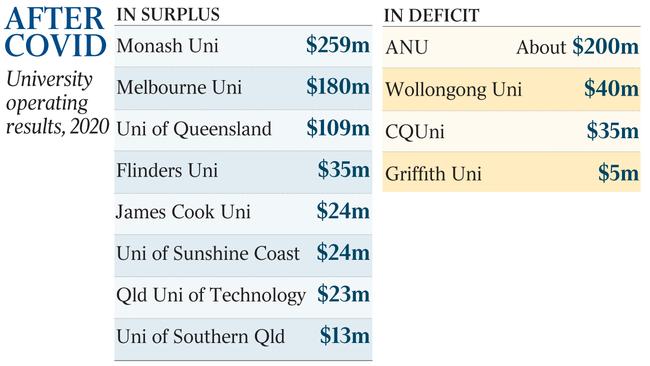Despite the pandemic most Qld universities are in the black
Despite a $250m revenue loss due to the pandemic, most Queensland universities were in the black in 2020.

Five out of the seven Queensland public universities posted operating surpluses in 2020 despite losing nearly $250m in revenue due to the pandemic.
According to their annual reports, tabled in the Queensland parliament, the only public universities in the state in deficit in 2020 were CQUni (which lost $35m) and Griffith University (which lost $5m).
Five others managed to stay in surplus with the University of Queensland in the black by $109m, James Cook University ($24m), the University of the Sunshine Coast ($24m), Queensland University of Technology ($23m) and the University of Southern Queensland ($13m).
READ MORE: Were the unis crying wolf? | Unis flout rules on English expertise | Plan to return 10,000 foreign students | CareerTrackers builds Indigenous skills | Coursera surges on market debut | Freedom for entrepreneurs!
Three institutions — James Cook University, the University of the Sunshine Coast and the University of Southern Queensland — managed to increase their surpluses (compared to 2019) despite the stresses of COVID-19.
The institution that suffered the largest revenue decline was the Queensland University of Technology, whose income fell by $112m in 2020 compared to 2019, mainly because of a $74m drop in unrealised investment gains, which are included in operational revenue in university accounts.
International student fees collected by QUT declined by $44m to $221m.
However, the university offset the revenue drop by cutting non-essential spending and reducing non-academic staff numbers. QUT’s overall spending in 2020 fell by $47m, including $20m saved in travel and staff development and training.
QUT vice-chancellor Margaret Sheil said the university’s financial results had benefited from the willingness of Chinese students to continue their degrees by studying online from their home country when their access to Australia was blocked by the closed border.
She said that, while staff had agreed to an enterprise agreement variation to pause pay rises and forgo a leave loading, there had been no forced redundancies at QUT.
The University of Queensland benefited financially from early calls made a year ago, when the pandemic hit, to cut spending.
“Decisions were made quickly and early in the year to reduce operating costs and defer expenditure,” vice-chancellor Deborah Terry said.
UQ’s spending on travel, staff development and entertainment fell 82 per cent, saving $49m. Professor Terry said the university had deferred $210m in new capital projects, but said these were being looked at again with a view to them going ahead but divided into smaller, more manageable pieces.
UQ suffered a fall of only 4.4 per cent, or $29m, in international student fee income, due to stranded students (mainly from China) continuing to study online from their home country.
Professor Terry said there was still solid demand from international students despite the pandemic and closed borders. This year’s intake of international students at UQ was only 10 per cent lower than before the pandemic in 2019, she said. International students had proved willing to enrol at UQ for online study from their home countries, postponing travel to Australia for on-campus learning until borders opened.
She also said the university was seeing strong demand for postgraduate study, with commencements up 12 per cent this year, partly because of the short courses that the federal government launched last year.
Universities in Queensland are the first to publish their official 2020 financial results, but others have released preliminary figures that show that Monash, Melbourne and Flinders also recorded operating surpluses last year. ANU and Wollongong have revealed they were in deficit.




To join the conversation, please log in. Don't have an account? Register
Join the conversation, you are commenting as Logout